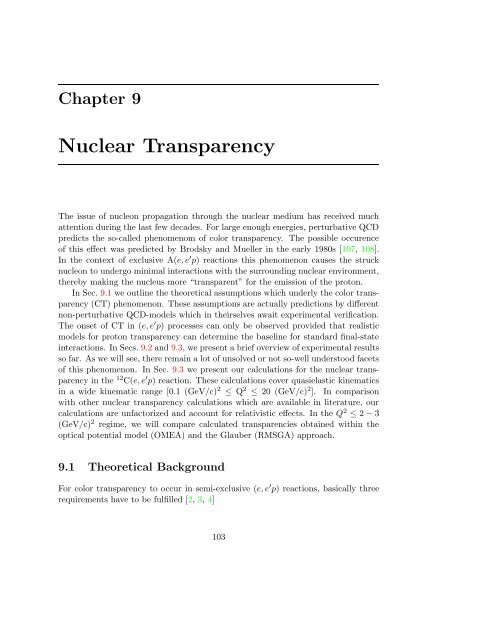Download Thesis in Pdf Format - Theoretical Nuclear Physics and ...
Download Thesis in Pdf Format - Theoretical Nuclear Physics and ...
Download Thesis in Pdf Format - Theoretical Nuclear Physics and ...
You also want an ePaper? Increase the reach of your titles
YUMPU automatically turns print PDFs into web optimized ePapers that Google loves.
Chapter 9<br />
<strong>Nuclear</strong> Transparency<br />
The issue of nucleon propagation through the nuclear medium has received much<br />
attention dur<strong>in</strong>g the last few decades. For large enough energies, perturbative QCD<br />
predicts the so-called phenomenom of color transparency. The possible occurence<br />
of this effect was predicted by Brodsky <strong>and</strong> Mueller <strong>in</strong> the early 1980s [107, 108].<br />
In the context of exclusive A(e, e ′ p) reactions this phenomenon causes the struck<br />
nucleon to undergo m<strong>in</strong>imal <strong>in</strong>teractions with the surround<strong>in</strong>g nuclear environment,<br />
thereby mak<strong>in</strong>g the nucleus more “transparent” for the emission of the proton.<br />
In Sec. 9.1 we outl<strong>in</strong>e the theoretical assumptions which underly the color transparency<br />
(CT) phenomenon. These assumptions are actually predictions by different<br />
non-perturbative QCD-models which <strong>in</strong> theirselves await experimental verification.<br />
The onset of CT <strong>in</strong> (e, e ′ p) processes can only be observed provided that realistic<br />
models for proton transparency can determ<strong>in</strong>e the basel<strong>in</strong>e for st<strong>and</strong>ard f<strong>in</strong>al-state<br />
<strong>in</strong>teractions. In Secs. 9.2 <strong>and</strong> 9.3, we present a brief overview of experimental results<br />
so far. As we will see, there rema<strong>in</strong> a lot of unsolved or not so-well understood facets<br />
of this phenomenon. In Sec. 9.3 we present our calculations for the nuclear transparency<br />
<strong>in</strong> the 12 C(e, e ′ p) reaction. These calculations cover quasielastic k<strong>in</strong>ematics<br />
<strong>in</strong> a wide k<strong>in</strong>ematic range [0.1 (GeV/c) 2 ≤ Q 2 ≤ 20 (GeV/c) 2 ]. In comparison<br />
with other nuclear transparency calculations which are available <strong>in</strong> literature, our<br />
calculations are unfactorized <strong>and</strong> account for relativistic effects. In the Q 2 ≤ 2 − 3<br />
(GeV/c) 2 regime, we will compare calculated transparencies obta<strong>in</strong>ed with<strong>in</strong> the<br />
optical potential model (OMEA) <strong>and</strong> the Glauber (RMSGA) approach.<br />
9.1 <strong>Theoretical</strong> Background<br />
For color transparency to occur <strong>in</strong> semi-exclusive (e, e ′ p) reactions, basically three<br />
requirements have to be fulfilled [2, 3, 4]<br />
103















